The next time that North Korea launches a ballistic missile, the projectile will be sighted by a Japan-based US radar perched on a bluff overlooking the Sea of Japan and turned west to face the Korean peninsula.
That radar is the sharp point of a highly sophisticated US-led tracking system that would quickly spring into action.
Some moments after the radar “sees” that North Korean missile, the weapon would be picked up by the Cobra Dane radar, a national intelligence sensor, on Shemya in the Aleutian Islands. At about the same time, the missile would be detected by another radar, encased in what looks like a giant golf ball and floating aboard a barge off the Alaskan coast.
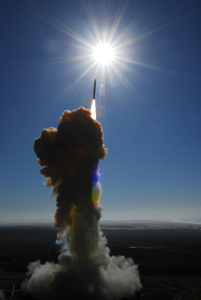 |
The Dec. 5, 2008 launch of a ground-based interceptor at Vandenberg AFB, Calif. |
Next to pick up the North Korean missile would be a satellite over the Pacific Ocean, the radar of a US Navy Aegis destroyer or cruiser sailing in the north Pacific, and yet another radar at Beale AFB, Calif.
All of this missile data will be instantly transmitted to a USAF command center at Yokota AB, Japan, west of Tokyo, where the take will be shared with Japan’s Self-Defense Forces. The data will be flashed to the 613th Air and Space Operations Center at Hickam AFB, Hawaii, and the US Pacific Command operations center on a hill overlooking the US Navy base at Pearl Harbor.
At the same time, fused data will be sent on to the US Northern Command operations center at Peterson AFB, Colo., the US Strategic Command underground operations center in Omaha, Neb., the National Military Command Center in the Pentagon, and the Situation Room in the White House.
Simply put, many military commanders and the Commander in Chief will be warned of the missile launch instantly and almost simultaneously.
On those screens will appear a tracking “fan” covering potential targets, with nontargets disappearing as sensors get a better fix on the missile’s trajectory. “That fan narrows pretty fast,” said Lt. Gen. Loyd S. Utterback, commander of Pacific Air Forces’ 13th Air Force at Hickam. “The computers tell us where the missile will hit and where we can hit it.”
All in the Planning
Ballistic missiles speed through three phases: Liftoff and boost, midcourse (when they leave behind their rockets and may shoot out decoys and multiple warheads), and terminal—when they hurtle toward their targets. Shooting down a speeding warhead anywhere in that sequence is akin to hitting a bullet with a bullet, but it’s been done before. DOD’s Missile Defense Agency, which is developing America’s missile defenses, plans to succeed with such intercepts.
For a defensive “bullet” to hit an attacking “bullet” requires sorting through many variables and rapidly integrating the relevant data: missile launch points, sensors, trajectories, possible targets, and data on the interceptors themselves.
MDA says it has plotted more than 50 scenarios, called Engagement Sequence Groups, for the computers to sort out. “It’s all in the planning,” said Rear Adm. Charles Martoglio, PACOM’s operations director.
In the scenario of the North Korean missile launch, the integrated defense is designed by MDA and actually executed by the Air Force, Navy, and Army. Computers at Ft. Greely, Alaska, would begin selecting interceptors to fire at the incoming missile from either Ft. Greely or Vandenberg AFB, Calif. Another fire control center does the same at NORTHCOM.
For all the high-tech glitz of this system, however, the “man in the loop” makes the decision on whether and when to pull the trigger. If the missile were aimed at Honolulu, it would take 23 minutes to get there. That would give the NORTHCOM commander, Air Force Gen. Victor E. Renuart Jr., fewer than 20 minutes to confer with the Defense Secretary or possibly the President before making a decision to fire.
If the target is in PACOM’s area of responsibility but outside of Alaska or Hawaii, that firing decision would fall to the PACOM commander, Adm. Timothy J. Keating.
This decision would not be as sudden as it sounds, because there may be days or even weeks of strategic signals providing warning of a pending launch. Utterback puts it this way: “Having a man in the loop started long before that missile was launched.” He means that US officials had been watching and listening to key factors all along.
First is the general state of US relations with potential adversaries.
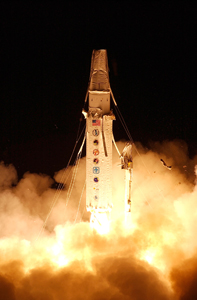 |
The launch of the long-range target it successfully ed out of Kodiak, Alaska. (photo by MDA)
|
Second is a coiling of forces indicating a strike is planned. North Korea’s missiles require liquid fuel, which takes time to pump.
There may be less strategic warning of a pending Chinese ballistic missile launch, because most of China’s missiles are solid fueled, ready to fire, and mounted on hard-to-locate mobile launchers.
“We watch capability more than rhetoric or intent,” said Martoglio. “Intent can change on a dime but capability can’t.”
In recent decades, large ballistic missiles have proliferated as the technology has spread. Where nine nations had them in 1972, the Arms Control Association now lists 32 missile-packing nations, from Afghanistan (where Soviet invaders left behind Scuds after withdrawing in the 1980s) to Yemen, which had been acquiring Scuds from North Korea.
MDA cited more than 100 foreign ballistic missile shots in 2007 and a similar number in 2008.
Initially, the threat from North Korea drove America’s land-based ballistic missile defenses. Daniel A. Pinkston, a specialist on North Korea’s missile program at the Monterey Institute of International Studies in California, wrote that in the 1960s “Pyongyang began to pursue the capability to produce advanced weapons systems, including rockets and missiles.”
“Foreign assistance and technology, particularly from China and the Soviet Union, were instrumental in the acquisition of these capabilities,” Pinkston said. “The ballistic missile inventory now totals about 800 road-mobile missiles, including about 200 Nodong missiles that could strike Japan.”
An infrared image of the collision. The Big Shock
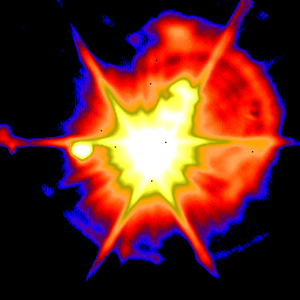
Other specialists believe North Korea has ballistic missiles that could hit Alaska, Hawaii, and the US West Coast.
The big shock came in 1998 when Pyongyang fired a Taepo Dong-1 missile over Japan into the Pacific Ocean, an event that rattled the Japanese government and people.
In 2006, Pyongyang shook Japan again by successfully testing six medium-range missiles and one longer-range missile that failed. US officers in Japan referred to the event as “Six Scuds and a Dud.”
China has had ballistic missiles capable of delivering nuclear warheads since 1966. According to the CIA, by 1998 China had 13 of its 18 intercontinental ballistic missiles aimed at US cities.
Estimates of China’s missile arsenal vary as China imposes strict secrecy. US officials with access to military intelligence reports have said that China has deployed 1,400 missiles just in the military district opposite the island of Taiwan.
The US, which maintains that Taiwan’s future must be decided peaceably, is all but obliged to defend it under the Taiwan Relations Act of 1979, which obligates the US to provide the self-governing island with arms to defend itself. Under consideration is a sale of 384 Patriot Advanced Capability-3 (PAC-3) defensive missiles.
For its part, Taiwan has developed two medium-range missiles in an effort to deter China. Realistically, however, the island is dependent on the US to ward off mainland China.
The Defense Department’s 2008 report on Chinese military power listed 1,480 ballistic missiles. The Pentagon estimated 60 intercontinental ballistic missiles are capable of hitting targets in the continental US. The exact numbers are murky, but the overall trend is clear—China is rapidly fielding additional ballistic missiles.
Short-range ballistic missiles, with flight times of about three minutes, are hard to bring down. US military planners have thus planned an “active defense,” in which enemy missiles and launchers may be destroyed with weapons such as cruise missiles before they could fire. In addition, new attention is being given to hardening targets to withstand missile attack.
North Korea and China are far from the only nuclear powers with active missile programs. Russia, India, and Pakistan all have ballistic missiles, as does nuclear aspirant Iran.
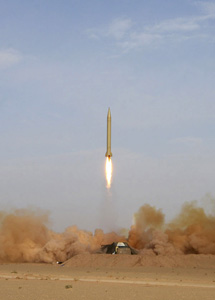 |
An Iranian Shahab-3 missile is launched in July 2008. Iran aspires to become a nuclear power. |
Perhaps the greatest foreign opposition to US-led BMD programs has come from Russia, which has harshly criticized US plans to build BMD sites in Poland and the Czech Republic. The US maintains that those sites would protect NATO against missiles fired from Iran, but Russia asserts the system is intended to negate Russia’s missile force.
US officials note that Russia’s vast ballistic missile inventory could easily overwhelm the system planned for Europe.
In response to the threats from Asia, the US in the last five years has deployed the X-band AN/TPY-2 radar to Shariki, Japan, and refurbished the Cobra Dane and Beale radars built to detect Soviet bombers. MDA has also built an X-band radar atop a self-propelled barge—with a crew of 86—stationed in Adak, Alaska.
In the Pacific are three Aegis cruisers and 13 destroyers with a BMD capability. Those ships have AN/SPY-1 sensors for tracking missiles, among their other duties.
The weapons to hit incoming missiles include 30 long-range interceptors based in Alaska and California since 2004. On ships are 29 Standard Missiles-2, intended to attack bogeys in their terminal phase, and 33 Standard Missiles-3 on Aegis cruisers and destroyers.
At Kadena Air Base in Okinawa, an Army battalion of PAC-3 air defense missiles was deployed in 2006 to bring down targets in the final phase of flight.
An MDA briefing says the agency has installed a network linking the combatant commands, NMCC, and the White House as the backbone of BMD. “None of this BMD capability existed in June 2004,” said Lt. Gen. Henry A. Obering III, when he was MDA director.
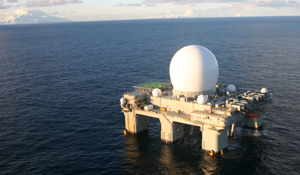 |
The Missile Defense Agency built this sea-based X-band radar atop a self-propelled barge and stationed it, and its crew, off the coast of Alaska. |
Obering has highlighted recent successful tests. The Army’s Terminal High Altitude Area Defense (THAAD), which has launchers on trucks, anti-missile interceptors, radar, and fire control apparatus, scored five hits in five tries. Aegis ships hit in 16 of 20 attempts, and USAF’s ground-based interceptors hit eight times in 13 tries. The Army’s PAC-3s were successful in 11 of 14 tests, and Aegis ships went two-for-two in terminal defense shots, the latest in June 2008.
29 Minutes and Down
In December, MDA launched a target missile from Alaska and tracked it with satellites and the numerous dedicated radars at sea and on land. The fire control center in Alaska ordered an interceptor fired from Vandenberg, which hit the target 29 minutes after liftoff.
“What is a first … is we actually networked it together, all of the different sensors,” said Army Lt. Gen. Patrick J. O’Reilly, MDA director. “They’re all different types of radars and different frequencies and sizes and geometries and were able to form one … very accurate track.”
President Obama’s plans for missile defense are unclear, but as a Presidential candidate he seemed skeptical. His Administration “will support missile defense, but ensure that it is developed in a way that is pragmatic and cost-effective and, most importantly, does not divert resources from other national security priorities until we are positive the technology will protect the American public,” Obama said then.
The Congressional Research Service’s Steven A. Hildreth reflected a skeptic’s concerns when he said he was personally “dubious of claims about the effectiveness of what we have deployed in Alaska and California.”
“Despite MDA’s assertions that their tests are operationally significant, I remain skeptical,” Hildreth continued. “The deployed system has not yet achieved operational or realistic test success neither in my own mind nor in the minds of many others. I suggest no one can have high confidence the system will work as intended in the case of an actual attack based on the test results to date.”
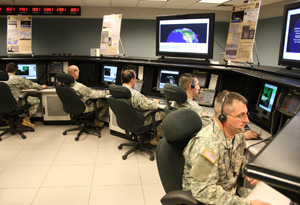 |
Members of the Alaska National Guard’s 49th Missile Defense Battalion operate the ground-based midcourse defense portion of the Ballistic Missile Defense System. |
Hildreth cited the disparity between the Patriot’s system’s early 17-for-17 test record and its shaky performance in the 1991 Persian Gulf War as a reason to view developmental test results with caution.
In any event, the BMD program worldwide cost $8.7 billion in Fiscal 2008, and MDA sought $9.3 billion for the current fiscal year. Funding was to climb gradually through Fiscal 2013. Those funds are to buy one ground-based interceptor a month, two Standard Missile-3s a month, three THAAD interceptors a month, and two radars a year.
Those budgets also include funds for research into interceptors that could strike a missile in the boost phase, the Airborne Laser program, and a kinetic warhead that would destroy a missile just by hitting it. MDA is also working on a multiple-kill vehicle that would destroy several warheads at once.
MDA says it has several goals that are still to be accomplished. These include better predicting the location of the enemy missiles, differentiating missiles from countermeasures, “communicating this information rapidly and accurately to the defensive system, and destroying multiple enemy missiles launched within seconds and minutes of each other.”
Nobody said it would be easy to hit a bullet with a bullet.
